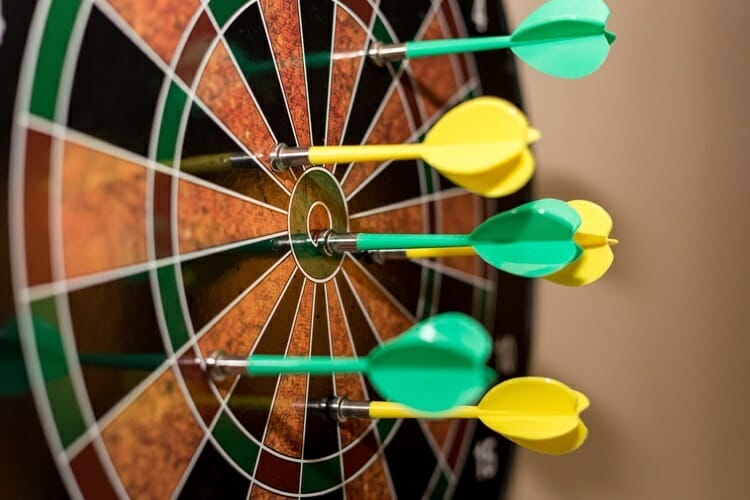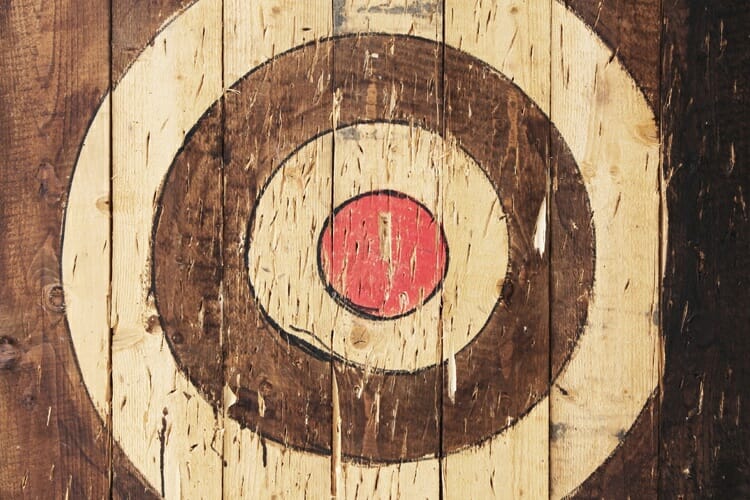A Brief History of the Game of Darts
Although the game of darts is based on precision, the history of the sport is anything but precise. But after sorting through the rumors and stories, a cohesive story does emerge. If you’re interested in the history of darts, then you’ve just hit the bulls-eye. Let’s get started on the story behind one of the world’s most popular games.
Contents
Ye Olde Merry Dart Players
Today, people play darts just about everywhere. Where there’s a pub or bar, there’s also likely a dart board. But before the game became a hit worldwide, it had humble beginnings in England sometime during the 1500s. The game of darts was most likely first created during the reign of King Henry VIII, although the creation was completely accidental.
The King believed the archers in his army would lose ability without regular practice. He wanted his army to always be at ready, even when no apparent threat was on the horizon. So he ordered his archers to practice their skills all year long.
Practice makes perfect but it can also be pretty boring, especially if you’re a soldier during peacetime. Soon the archers focused less on practice and more on drinking and hanging out. Eventually, a new game was created by the men.
The alcoholic drinks of the day were ale, beer and wine. All of these were typically stored in large wooden barrels. Typically stored horizontally, the barrels had large circular targets on each end. To a bunch of drunk archers, those round circles made tempting targets.
A game developed. The archers would throw their arrows – using their hands and arms instead of their bows – at the circles. Soon enough, they realized throwing arrows was a game of skill instead of chance. They began to refine their techniques and compete to see who could get closest to the center of the ring.
But then a problem arose: England’s weather. As the days and nights become colder and wetter, playing the new game became increasingly unappealing. Rather than be miserable outside, the players moved the game inside to the local pubs.
Indoors and Away from the Rain, the Game of Darts Officially Begins
As an indoor game, some slight changes had to be made. The regular arrows were too long, so they were shortened. This improved accuracy when throwing. Plus, shortened arrows are much easier and safer to use indoors than standard-sized arrows.
Once the game moved indoors, the dartboard underwent a radical re-design. The growing popularity of the game began to deplete the supply of wine barrels. Instead, they began to make their own boards from trees.
An interesting thing happens when you turn a living tree into a thin piece of wood. Rings from the tree are visible. These rings were the original basis for the point system found on dart boards today.
The game continued to evolve from a way to pass the time to a game of skill. Players started making their own shortened arrows at home. They’d bring these custom sets to the pub and challenge others to what was now being called “darts.”
Upper Classes Join the Fun
The game quickly grew in popularly, expanding well beyond soldiers in pubs. Upper classes started to play, too. Of course, they didn’t particularly want to play in pubs with the common folk. Instead, the aristocracy wanted to play at home with custom dart sets and boards.
In 1530, darts reached a then-pinnacle of popularity when Anne Boleyn gave an ornate dart set to her husband-to-be Henry the VII. This wasn’t just a gift given out of love, either. It was a calculated gift to help win the King’s favor. One dart set actually had a significant impact on history!
Darts spread around the world. Most historians believe the game came to America aboard the Mayflower in 1620. Pilgrims played the game to help pass the time during their long voyage at sea.
Keeping Score: How Modern Dart Scorekeeping was Created
Even though the tree rings on the original dartboard provided a measure of accuracy, darts didn’t have much of scoring system until almost the 1900s. From 1800 to 1900, the rules for games of darts were all over the place, varying from player to player.
There was even a version of the game popular in 1844 called Puff and Dart. Instead of throwing the darts by hand, players used a blowpipe. But this game’s popularity was, well, short-lived after a London player accidentally inhaled a dart and died a few days later.
In 1896, an English carpenter from Lancashire named Brian Gamlin invented the dart scoring system which is still used today. The number 20 is at the top, then clockwise the numbers are 1, 18, etc. The entire system is designed to penalize inaccurate throws.
Unfortunately, Gamlin died in 1903. He was never able to patent his revolutionary idea. However, his system, even hundreds of years later, is still considered the best numbering system for perfect randomness.
But the entire story isn’t agreed upon by historians. There’s not an overwhelming amount of evidence Gamlin every existed. Of course, that’s not completely bizarre for someone who lived in 1903 and whose main achievement was only recognized after his death. Still, some dart historians credit a man named Thomas William Buckle with the invention of the modern-day dart scoring system.
At the time, the highest score available was the bulls-eye. Triples and doubles were added later.
Types of Dart Boards
There are a variety of dart boards both historically and in use today. Probably the most common type of dart board is what’s called the Standard, Trebles or London board. This type uses colors to designate each scoring section.
Other popular board types include a Standard-variant called the Yorkshire, a colorless board called the Lincoln, a smaller board known as the Manchester Log-End Board and many more.
As the game grew in popularity, more variations of dart boards were created. This is due to player tastes as well as resource availability. After all, when darts was first created, every board had to be made by hand from materials found in the nearby environment.
The History of the Dart Itself
Although Gamlin made significant contributions to the game, he wasn’t the only individual to have an influence. During Gamlin’s time, darts were four-inch long wooden pieces called a “barrel.” Each barrel had a metal point on side, with feathers on the other to aid flight distance.
In 1898, an American patented the first paper folded dart. Paper not only improved accuracy, it was also much easier and cheaper to obtain than feathers. Shortly after, in 1906, an Englishman invented and patented the first metal barrel. Now each dart in a set could easily be made uniform, which helped keep play consistent.
Final Thoughts
With a scoring system in place and a new dart now design, the modern game of darts was ready to take the world by storm. Today darts is a game enjoyed by people all around the world in bars, rec rooms and more. Players of practically all ages and skill levels can enjoy a game. You can even find plastic dart sets so kids can play.
While the history of darts is filled with a lot of rumors and mystery, there’s no doubt darts is a great game which is sure to remain a classic!


